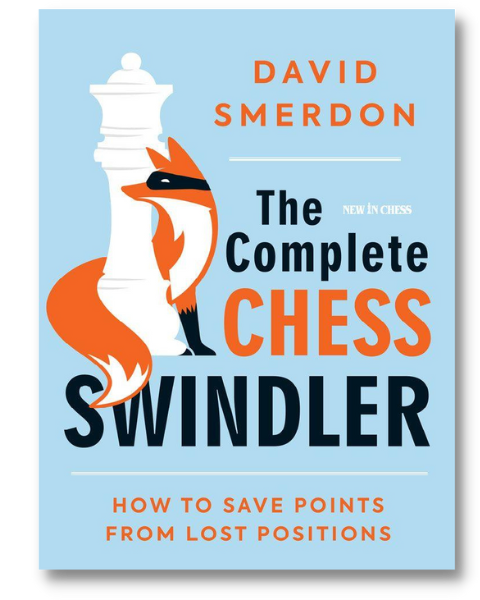Book Review of The Complete Chess Swindler by David Smerdon
“Chess is in the last resort a battle of wits, not an exercise in mathematics. Theory helps you; but you have to fight. Hence our contempt for the stupid word ‘swindle’ in chess.”
– C.J.S. Purdy, as quoted in this book.
The late C.J.S Purdy may have been the father of Australian chess and the first World Correspondence Chess Champion, but it’s clear from the quote above that his countryman GM David Smerdon disagrees with Purdy’s views of swindles. And it’s just as well too, because otherwise this very original and entertaining book would not have been written!

In the introduction to the book, Smerdon emphasizes that swindles are meant to be tried against human opponents; it’s essentially pointless to try to swindle a super-strong chess engine. He also says that “swindle-mode” thinking is useful when a player is about to resign because he is clearly losing. This is the time to start thinking about making the opponent’s life difficult and exploiting chess psychology. Of course, swindles won’t work if the opponent is alert to the idea, but if the position is lost anyway, it can’t hurt to try.
He offers four possible flaws that can be exploited, namely impatience, hubris, fear and kontrollzwang (the compulsion to keep the position under control), and suggests the following four strategies for them:
- Trojan horses for impatience
- Decoy traps for hubris
- Berserk attacks for fear
- ‘Window-Ledging’ for kontrollzwang
These strategies make up the swindler’s toolbox that is discussed in Part III of the book, while Part IV discusses the core skills required for a successful swindle. Stalemate, perpetual check, and fortresses are particularly important tools. All these topics are covered in great detail and in an entertaining way. The annotations are clear and precise, and Smerdon also provides some pertinent background to the games in many of the examples.
The book concludes with three chapters with 108 exercises for the reader to solve. These exercises are quite different to the normal “find the winning move” types. Here, the task is to try to find a way to potentially swindle the opponent! It’s not easy to adjust to this type of exercise, but the effort is certainly worthwhile.
Two examples from the book are given below, with annotations from the book.
The Complete Chess Swindler: Example 1
The Complete Chess Swindler: Example 2
Forty years after his death, Purdy continues to have an enviable reputation as a chess author. With this book, Smerdon clearly shows that he is a worthy successor to Purdy, and the book is a fine addition to the Australian chess literature and a great book in its own right.
Watch GM David Smerdon talk about his book and how to use psychology to swindle your opponent in chess:
Have any thoughts or questions? Let us know in the comments!
For a limited time, get The Complete Chess Swindler with a special 10% discount offer at forwardchess.com.

- New Release: Chess Analysis – Reloaded - March 9, 2024
- Review: The Art of The Endgame – Revised Edition - February 14, 2024
- Review: Study Chess with Matthew Sadler - December 13, 2023
